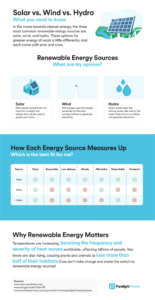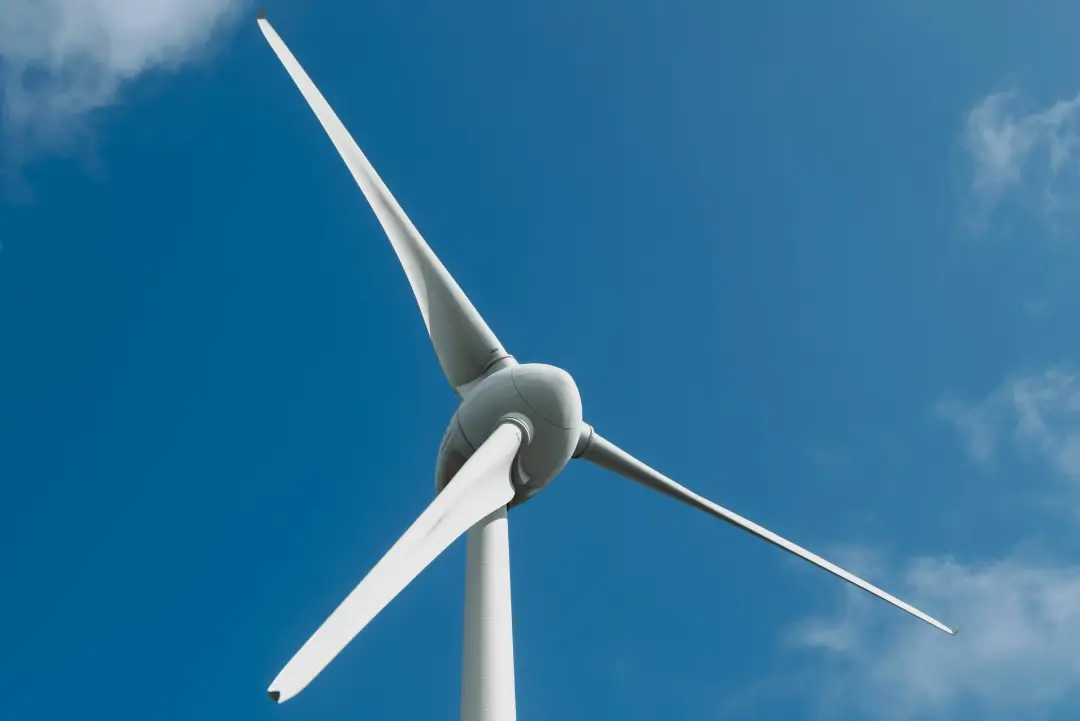Wondering what makes energy renewable or not?
Renewable energy is energy that comes from a source that isn’t finite. For example, the sun, wind, rain/water, heat, and waves are all renewable energy sources – with a little help from some cool technologies. In the U.S., the most common renewable energies for use at home are solar panels, wind, and water.
Non-renewable energy is finite, so we’ll run out of it eventually and have to change how we power our lives. Fossil fuels are non-renewable energy sources. We’ve been using fossil fuels as a source of energy for as long as humans have been around, like our use of coal.
As our world grows, the amount of fossil fuels we use to power everything — from our homes to global trade — has increased. With so much reliance on fossil fuels, we’ll eventually use up that supply — and contribute to air pollution. But our world won’t stop growing, so we need to develop clean energy sources to power our homes and lives that don’t rely on fossil fuels.
What is Solar Energy?
Solar energy is power created by harnessing the sun’s rays through solar panels. Solar panels absorb sunlight and then convert that into electricity through a process called the photovoltaic effect, which creates solar power.
With the sun always around to help photovoltaic (or PV) panels create electricity, they’re fast becoming a popular power source. Solar power has been one of the fastest-growing renewable energy sources. In 2020, solar power comprised 3.3% of total US energy generation.
Solar energy can power homes, businesses, cars, aircraft, and electronic devices. According to the United States National Renewable Energy Laboratories (NREL), the amount of energy from sunlight that hits the Earth in one hour could supply the world’s energy needs for an entire year.
With solar becoming more widely available and used in homes, and technology becoming more advanced, solar also becomes more affordable for homeowners. The industry-standard lifespan of solar panels is about 25-30 years, so you’ll likely have them for as long as you live in your home.
What Are the Benefits of Switching to Solar?
Homeowners who switch to solar can see a lot of benefits, including:
- Renewable energy has lower emissions (CO2 or other greenhouse gases) than traditional power sources. You’ll get the electricity you need, without worrying about how you’re impacting the earth.
- With technological updates, solar is becoming more affordable for homeowners – and Purelight Power’s $0 out-of-pocket solar makes it even more affordable for customers to make the switch to solar.
- Solar is sustainable and will always have its energy source: the sun
- Solar adds equity to your home and increases its value by 4%.
- Low maintenance – other than cleaning your panels a few times a year, there’s not much maintenance involved.
- Right now, it’s extra affordable. Current federal and state tax incentives and rebate programs help you switch to clean solar energy for less!
Cons
- You’ll need a fair amount of space, like your roof, in order to offset your power bill by 94% or more so you no longer have to pay the power company.
- Weather can affect your panels’ energy production. When there’s not a lot of light from the sun, like cloudy, rainy, and snowy days your panels can’t perform at maximum capacity. The good news is you can draw on the extra power you did produce during sunny days with net metering.
- To some homeowners, solar panels aren’t pleasing to the eye. But a slightly different look to your roof might be offset by bragging rights of owning your power and being the greenest house on your block.
- You can’t take a rooftop home solar system with you. So if you’re planning to move soon, unless you want to immediately increase the value of your home by 4% or more, making the switch to solar right now might not be for you.
How do we use water for renewable energy?
According to the Office of Energy Efficiency and Renewable Energy, “hydropower is the most widely-used renewable power source, accounting for more than 37% of total U.S. renewable electricity generation and about 7% of total U.S. electricity generation.”
Chances are, especially for homeowners in the US, you’re already getting some of your electricity from hydropower.
Hydropower, or hydroelectric power, is a renewable source of energy that generates power by using a dam or another structure, such as a turbine set in the ocean, to turn moving water into electricity. Did you know, hydropower is one of the oldest renewable energy sources used widely in the U.S?
But how does water become electricity? As the water passes through a turbine’s blades, it starts the generator to convert the motion of the water into electricity.
If you have water flowing through your property, you might consider building a small hydropower system to generate electricity. A micro-hydropower system needs a turbine, pump, or waterwheel to transform the energy of flowing water into rotational energy, which is converted into electricity.
Benefits
- Hydropower uses water to generate electricity, so it’s a clean source of energy.
- If you have natural running water next to your property you would be able to use that natural resource as a form of energy and not have to rely on an outside source of energy.
- Hydropower at the community level often creates reservoirs that offer public recreational opportunities, like fishing, swimming, and boating. Clean energy and fun on the water? Win-win.
- As an energy source, hydropower provides more than just electricity. The reservoirs created by hydropower using dams also provide clean drinking water, flood control, and irrigation support.
- Currently, hydropower is one of the most efficient energy sources. Hydroelectric dams are about 90% efficient at converting water into electricity.
Cons
- The biggest drawback of hydropower is the huge environmental impact on the community. When a dam is constructed, new roads, electrical lines, and more construction has to happen. And, the part of the river dammed is flooded, which may displace people living nearby.
- The risk from dams involves possible flooding.
- It’s expensive to build dams and reservoirs and can take two to five years on average to build, with larger projects even surpassing that. The climate also affects how well hydroelectric can work. Droughts are becoming more frequent in the US, which can create a problem since water is the only resource that generates electricity with hydropower.
Wind Energy
Wind turbines convert the energy that is produced from the motion of the wind into mechanical power. Then a generator can convert mechanical power into electricity. Wind turbines work almost as engines do, the winds start to spin the propellers, the propellers then start to spin around a piece called the rotor, which turns the drive shaft which turns an electric generator.
Three factors affect the amount of energy that can be produced from the wind: wind speed, air density, and swept area. Because of this, wind energy is best suited for areas with regular high winds – like off the coast, in deserts, or throughout the American prairies.
Benefits
- The wind is clean and renewable energy which, like solar and hydro, doesn’t directly emit greenhouse gases like burning fossil fuels. Also, the wind is something that will continuously exist. But with that being said there are plenty of days where there is no wind at all.
- Once you install a wind turbine or wind farm it has low operating costs since the power source itself is free. Although you will have to pay for routine maintenance done every six months, and eventually replace the whole system around 20 years.
- Wind turbines don’t take up much space on the ground. Like solar, they can be placed in areas where they don’t get in the way, like being placed on your roof or on the ground.
Cons
- Because wind is unpredictable, it’s hard to know how much energy wind turbines will create at any particular time. If there are only low winds, the rotors won’t even turn, meaning no electricity would be generated.
- With the wind turbines, some people who live nearby complain of noise disturbance.
- Because turbines are built high off the ground to capture the wind, they can also be eyesores for people who would prefer a landscape without them.
- Similar to tall communication towers and electric lines, wind turbines can harm birds and bats that fly near the turbines. Like hydro, the moving parts of the system pose a risk.

Sold on Solar? Purelight Power Can Help You Make the Switch!
Solar is a dependable, renewable option for home energy, drawing on the energy of the sun with solar panels installed out of the way on your roof. Over a million U.S. homeowners have already chosen the sun as their source of power.
Now is the time to own solar for $0 down and wipe out your power bill!




